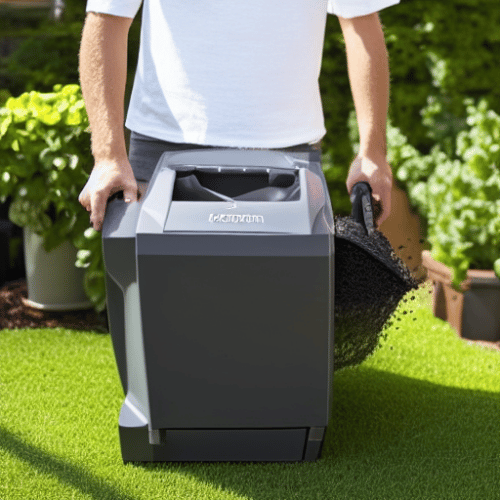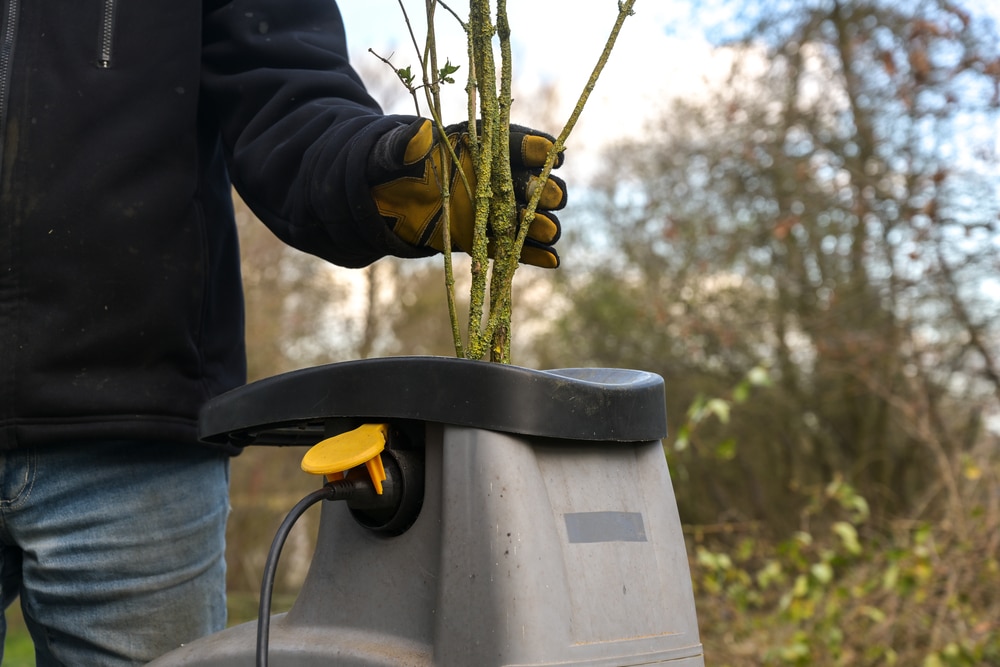Last Updated on
Keeping your garden tidy can be difficult. It can also be tough work! It is where a garden shredder helps reduce the workload. As you will see, garden shredders are helpful tools that help reduce garden waste. Additionally, they support recycling and can help create garden compost, which will benefit a healthy garden. In this guide, we answer the question, “what is a garden shredder” and look at what these tools have to offer!
The Main Components of a Garden Shredder
You should first understand the different components of a shredder and what they look like. These are relatively large items that are usually mounted on a set of wheels. It means you can pull them around larger gardens easier. There are also five main components described below – the housing, shredding blades, input area, output area, and collection bin.
Main Housing
The main body of the shredder is the housing. It is often rectangular in shape, but it will have the input and output areas protruding. Within the housing, you have the motor that powers the shredding blades. The blades will be able to rotate at various revolutions per minute thanks to a fixed voltage and power rating.
It will usually have a control panel with a power switch and, depending on the model, settings to adjust the blade speed. The electric cable will also connect from the main body. Housings are typically made of durable plastic but may have metal components too.
Shredding Blades
The blades of a shredder are situated within the main body. These are what shred the material and turn it into mulch! The blades are usually configured in a staggered formation or on a circular disk. Their fast rotating motion and the downward force exerted when the material is pushed onto the blades make for a quick and effective shredding process.
It is important to look at the blade or plate type. Some blades wear out quicker. Also, some blades can only tackle lighter materials. Other blades are also reversible. It means that when one edge is blunt, you can flip the blade over and use the other side.
Felt a bit burnt out yesterday so designated this morning for tackling the garden. Several hours later, the old wall is now starting to reappear and I have realised I need a garden shredder #QuarantineProject #SpringSunshine #IvyOverlord pic.twitter.com/cIeyVfRt6Y
— Aileen Howell (@AileenH) April 25, 2020
Input Area
The input area is where you feed the material. It is located at the top of the shredder. It is positioned this way so that gravity can aid in the shredder process. Some garden shredders have a longer input area – almost like a chute that makes it easier to feed long branches and twigs.
The input area will lead directly onto the blades. As described below, all you have to do is feed the material through the input area onto the blades.
Output Area
Once the garden weeds, plants, wood, and other items are shredded, they pass into the output area. It is usually located at the bottom, or the side of the shredder, below the cutting mechanism. In most instances, the output area is simply an opening. The shredded mulch is shot out of this area – ideally into an attached collection bin. However, some garden shredders do not have collection bins, and the output area will empty directly onto the ground.
Collection Bin
Lastly, many garden shredders have a collection bin. It is attached to the output area and catches the discarded items once they have been shredded. Typically, the collection bin is a simple plastic storage container that can be easily attached and removed.
Collection bins make the job easier and help create less mess. If your shredder does not have a collection bin, we suggest buying a plastic container to collect your garden waste.
How to Use a Garden Shredder

Now that you understand the basics of garden shredders, we can look at how to use one. Garden shredders are not particularly difficult to use. Providing that you understand how the device works and its components, you should be able to use one effectively. However, there are certain tricks and tips you can use to make the process easier.
Safe Usage
Safety is highly important when using any garden equipment with a cutting feature. Also, garden shredders can be potentially dangerous. It is because of the input area, the material feeding, and the cutting. If you are not careful, your hand or arm could get dragged into the input area and result in a serious injury. Also, shredders are relatively noisy and could damage your hearing.
Therefore, make sure you always use the correct safety equipment! Firstly, ear defenders are vital to protect your hearing from the loud and constant shredding noise. Next, we advise wearing gloves. Protective gloves will first stop splinters and cuts from the trees and branches. They will also offer some protection as you feed the material.
Finally, eye protection is advisable too. Although you are forcing the items down, flecks and debris could still fly up and hit you in the face. Protective glasses make sure that your eyes are safe.
Today I have been shredding brambles and wood. I have been using a garden shredder… and my face.#minorinjury pic.twitter.com/aChr6AyZgz
— John Rockley Chart. PR MCIPR (@JohnRockley) March 20, 2021
The Shredding Process
Before starting the shredding process, we advise reading the instruction manual fully. You must be aware of how the device works, its safety features, and how to feed the items properly.
Positioning is also important. Ideally, you want to position the shredder next to the pile of materials you want to shred. It means there is less mess and less chance of items dropping on the ground as you carry them.
The basic process is simple. You turn the device on and feed the materials through the input area onto the blades. Some shredders have continuous blades that work all the time. Others may be pressure sensitive and only activate when the material is touching them. Regardless, as soon as the item touches the blades, they should pull it through automatically. At this point, you can release the item to reduce the chance of an accident.
Who doesn’t love a garden shredder?? Even Barry’s made an appearance!!! #gardening #shredder pic.twitter.com/zJb8jHEz0S
— Garden Ninja: Lee Burkhill (@Garden_Ninja) July 18, 2020
Collection and Waste Removal
What you do with the waste material is also important. As mentioned above, you should have a collection bin. It should be positioned directly below the output area. As a result, the mulch will shoot straight into the bin and not spray on the floor.
We also advise that you empty the collection bin often. Don’t let it get too full. Shredded and compacted garden waste can be heavy! Therefore, it will give you less strain if you empty it often – either into a garden waste bin or your compost heap.
It is also advisable to shred little and often instead of leaving your garden for months on end. If you shred often, you can keep on top of the job and reduce the overall work required. It also means you can keep a constant supply of compost if you utilize the waste for your composting.
Uses for Garden Waste From Garden Shredders
The great thing about using garden shredders is that they have a dual purpose. Primarily, they aid garden waste collection. Indeed, they are fantastic for keeping on top of a large garden and keeping it tidy. However, the material and green stuff you collect can also be utilized elsewhere!
If you want to have a self-sufficient garden and use environmentally-friendly practices, a shredder is a great gardening tool to have. The following are two ways you can utilize the material your garden chippers make:
Reason to own a garden shredder 🙂 pic.twitter.com/7XpxI31zKZ
— LinkoVitch (@Link2076) May 12, 2019
Compost
Primarily, green materials like hedge trimmings, leaves, and grass cuttings are amazing for composting heaps. If you have hot composting or a large compost heap, you can keep it topped up with the material from your garden! If the composting bin is the right size, you could even position it directly below the output area of the shredder so that the shredded items can go directly into it!
By utilizing garden waste as compost, you can save on expensive fertilizers. Also, this is a healthier and environmentally-friendly method. You are essentially recycling dead garden materials. The compost can then be used as fertilizer for your soil, vegetable patch, and flower arrangements, promoting growth and giving the bare soil the nutrients it needs.
Wood Chippings
Alternatively, the brown waste you create from your shredder can be used as wood chips. Items like woody branches, twigs, tree bark, and bush branches, for example. This is essentially what proper wood chippings are made of – woody material. Instead of buying expensive woody material chippings from a garden centre, you can create your own using a shredder!
Wood chippers specifically are great at doing this. You must also use the best settings. If you cut the woody material too fine, you create a wood mulch which may be too small and fine to use as chippings. Ideally, the shredded material should be large enough to provide great coverage for the area you want to have chippings on.
Garden Shredder FAQs
Are Garden Shredders Loud?
Unfortunately, most shredders are loud. The basic process involved is difficult to make quiet. The metal blades effectively grind the material, and the sound of the twigs, mulch, and branches going through are virtually impossible to reduce. It is why wearing ear defenders is essential when using a shredder.
What Kind of Gardening Materials Can Be Shredded?
These machines can shred a huge variety of larger garden and smaller garden items. They are brilliant for shredding softer material like leaves, grass cuttings, weeds, and plants. Also, an impact shredder or powerful chippers can be used to tackle tougher items like larger branches, twigs, and bamboo. You can even use a turbine shredder to mulch food waste like vegetable and fruit peelings!
Can a Shredder Break Tree Branches?
Yes, but it is essential to look at the specifications of the shredder. Some shredders are only suitable for smaller branches and lighter items. Others, however, have tougher blades and a more robust shredding mechanism. These petrol shredders and most impact shredders are great for destroying large branches.
I bought a garden shredder. pic.twitter.com/Jadkfry7t0
— Angela Coraccio (@slickfixation) September 26, 2020
Get Your Garden Shredder
Since you already know the answer to the question, “what is a garden shredder?” then it’s time for you to decide whether you need to have it or not in your garden.
Garden shredders are fantastic tools to have. Using an electric garden shredder, you can reduce garden waste, keep your outside areas tidy, and also improve your composting process. Not only can these machines help reduce waste, the wood chips, wood mulch, and grass clippings can be used as compost to fertilize your soil or a vegetable patch. If you take pride in your garden, why not consider investing in one today?
Paul is the type of person who never met a problem he couldn’t fix. He can always be found tinkering with something in his house, even if it isn’t broken! His tips and tricks are often shared on our site. He’s the one you call when something breaks because he has been known to improvise fixes for everything from leaky faucets to malfunctioning dryers.



